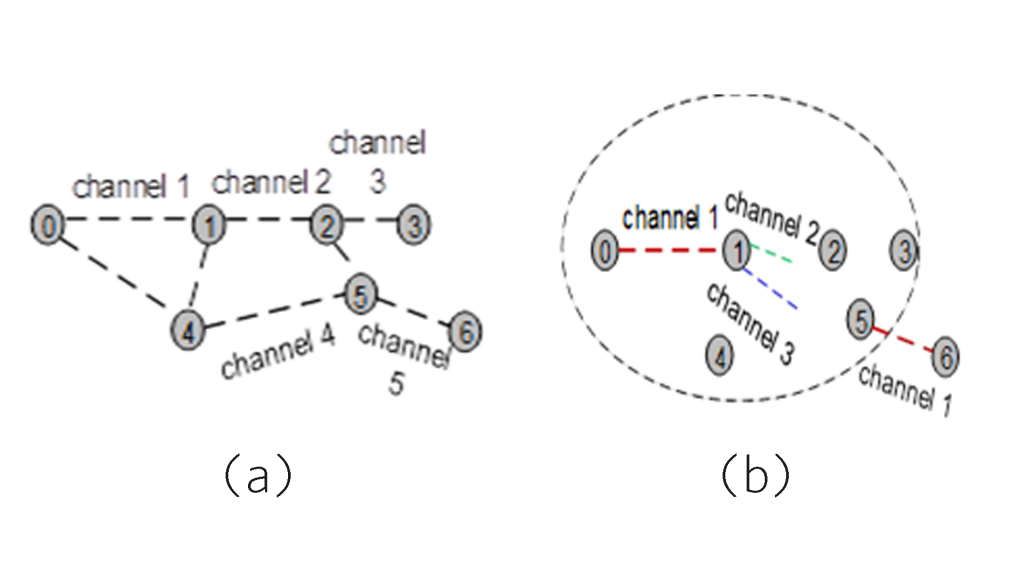
Devices in wireless networks can operate on multiple channels and automatically adjust their transmission rates for the occupied channels. While a higher transmission rate potentially contributes to a higher transmission throughput for wireless applications, it may result in a smaller area being covered.
This is because at a given transmission power, there is a tradeoff between achievable throughput and coverage of wireless signals. Our simulation results (Figure 1) show this relationship between transmission distance (such as the radius of wireless coverage) and the different transmission rates in a line topology.
From this, we can see the importance of extending the coverage of high-performance wireless communications.

Can multiple channels help to improve the throughput-coverage tradeoff?
Several different techniques to address this tradeoff have been studied. For example, researchers have proposed enabling a wireless device to transmit multiple times. Each time, it was via a different channel at a different rate, so that nearby users received transmissions with a higher rate. Meanwhile, distant users could also receive data via a lower transmission rate. The same data, however, needed to be transmitted multiple times by the same devices.
A proposal for improving the tradeoff
To improve the throughput-coverage tradeoff without issuing additional traffic load, we propose Parallel Low-rate Transmission (PLT) in which a wireless device employs multiple channels to transmit at a low rate in parallel. Under PLT, wireless signals will reach longer distances. Also, the aggregated transmission rates through multiple channels will enable a wireless device to admit an application with a high transmission rate. The PLT transmissions do not require the same data to be transmitted multiple times and all receivers will have similar-quality communications.
Read: Can wireless mesh networking carry long-distance communications?
The effectiveness of the PLT transmissions relies on the availability of a number of orthogonal channels, such as wireless channels having non-overlapping radio frequency. Some recent IEEE standards allow the flexible division of frequency bands when forming channels, helping to create more orthogonal channels. For instance, IEEE 802.11n has up to 24 channels and IEEE 802.11ac has up to 25 channels. Other IEEE standards (IEEE 802.11b) support a very limited number of orthogonal channels (like three orthogonal channels with IEEE 802.11b).
However, regardless of which IEEE standards are adopted, the continuing rapid growth in the number of devices and the number of applications in wireless networks necessitates control of the number of orthogonal channels used when addressing the throughput-coverage tradeoff.
How can we apply PLT transmissions with a controlled number of orthogonal channels?
It is worth noting that in Figure 1, a transmission with a higher rate can deliver a greater throughput to a larger area via a greater number of hops.
The 5.5Mbps transmission delivers an effective throughput of 1.46Mbps to an area with a radius of 702m via two hops, while the 2Mbps transmission can only deliver an effective throughput of 1.28Mbps to an area with a radius of 369m. Therefore, a potential way to reduce the number of employed orthogonal channels is to transmit at a high rate via more than one hop.
This is where Alternative Rate Transmission (ART), a system we devised, can be used. With ART, wireless nodes are classified as regular nodes and PLT nodes. Regular nodes use single channels to transmit at a higher rate, while PLT nodes employ more than one channel to transmit at a lower rate.
This begs the question: How can we determine which nodes should be regular nodes versus PLT, and at which rates the regular or PLT nodes should transmit?
How do we avoid interference between hops?
Instead of discussing the detailed analysis here, I’d like to share some broader conclusions. In order to avoid interference between different hops, the locations of PLT nodes are decided by the transmission range of the adopted high transmission rate and the interference range of the adopted low transmission rate. Ideally, the high rate should match the application’s transmission rate, and the low rate for PLT transmissions is determined by channel availability.
Figure 2 shows an example of transmissions with (b) or without (a) our ART transmissions. In this example, ART transmissions manage to employ only three channels to cover all wireless devices with a high transmission rate, using two fewer channels as compared to transmissions without alternative rate transmissions.

Wanqing Tu is an Associate Professor in the Department of Computer Science at Durham University, UK.
The views expressed by the authors of this blog are their own and do not necessarily reflect the views of APNIC. Please note a Code of Conduct applies to this blog.
